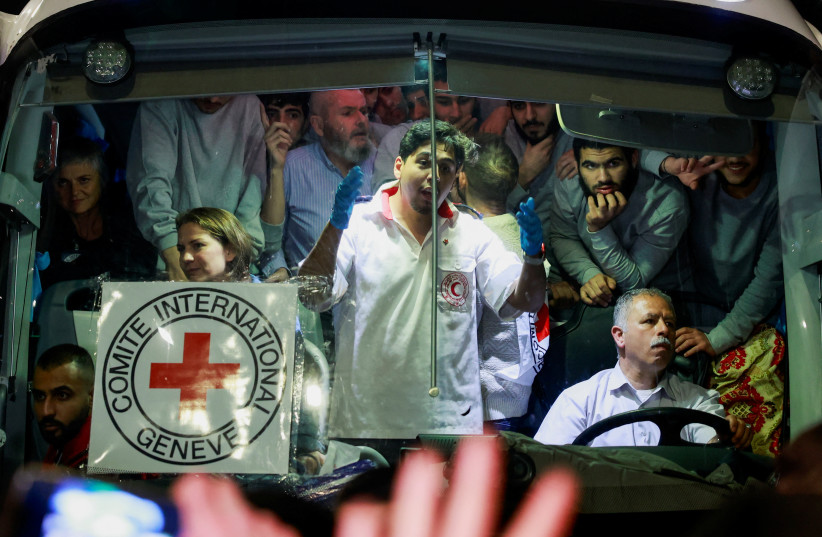Hamas is targeting the West Bank following the Gaza hostage and ceasefire deal. The prize for Hamas has already been obtained in images of Palestinian prisoners released amid Hamas flags flying in places like Betunia in the West Bank near Ramallah. This was one of Hamas’s goals all along since October 7, and was also likely the goal of Hamas leadership abroad, in Qatar, and of Hamas backers in Iran, Turkey, and other countries.
More disturbing are images of two men, apparently murdered due to accusations of “collaboration” in Tulkarm. The images show the men dragged in the street, hanged from an electric pole and then displayed in public as crowds of men photograph their bodies. These are reminiscent of the crowds of men chasing after bodies that Hamas paraded in Gaza on October 7.
Two days ago, video filmed in the northern West Bank and posted on social media showed a failed launch of a rocket near Jenin. This was one of several failed rocket launches by Iran-backed terrorist groups near Jenin over the last year. In addition, an attempt to smuggle pistols to the West Bank was also intercepted recently, according to images posted on social media.

As prisoners were released on Friday, people in the West Bank chanted support for Hamas. This was the “prize” that Hamas wanted since October 7. The mass attack on Israel may not have played out exactly as Hamas expected. Hamas apparently was able to kill more people and take more hostages than it planned for; but the overall goal was for Hamas to get attention in the region and globally; and for Iran and Hamas backers to grow their influence in the West Bank.
This comes in the context of an aging Palestinian Authority leadership and the erosion in security in the northern West Bank over the last year. Palestinian Islamic Jihad and other armed gangs have succeeded in spreading instability in Jenin, Nablus, Tulkarm and other areas. This forced Israel to launch increased raids in Jenin in the last year.
Hamas is now able to exploit the ceasefire deal, which Israel calls a “pause” in the fighting, to drag it out, delay hostage releases, and therefore slowly “drip-drip” the release of Palestinian prisoners to milk every release for propaganda. This is a method that is known to Hamas backers in the region. Hamas has sophisticated regional support, not only in Iran but also among activists in Turkey, and Hamas leadership in Doha and elsewhere.
It’s important to understand the major tectonic shifts that may be at work globally. Hamas exploited the Russia-Ukraine war to get backing from Moscow and also get Beijing not to condemn the October 7 massacre. It also has gotten support from countries such as South Africa and countries that are members of the BRICS group.
This is important, because Hamas is leveraging October 7 as part of the anti-western bloc formed by Iran, Turkey, Russia, and China. Hamas is also exploiting protests in the West for its own goals. There is no shortage of commentary now in the West excusing Hamas crimes; for instance people ripping down photos of the hostages, people claiming that Hamas is “resisting” Israel, even excusing the murder of “collaborators.”
Some now suggest Hamas be brought back to the West Bank, welcomed by the Palestinian Authority, and enabled to run in elections. It may be “asked” to disarm, the way Hezbollah was asked to disarm after 2006. Hamas rejected the presence of international or Arab monitors in the Gaza after the war.
The fact that Hamas may have lost numerous fighters and battalions in battles for the northern West Bank, but is easily able to take part in the hostage ceasefire talks, illustrates its game plan. Hamas leaders abroad have impunity. They may not direct day-to-day operations in Gaza, but they are in touch with Iran and other countries at the highest level.
While some international organizations refer to Hamas as an ”armed group” in Gaza, not even naming it, some countries in the region treat it as the government of a state.
This is important. The Palestinian Authority has not been bolstered by regional countries or other countries since October 7. It has lost clout. The fact that Spain says it is now open to recognizing a Palestinian state, even if the EU does not change its policy, illustrates how Hamas has gained through the massive attack and holding child hostages. Hamas crimes didn’t erode support for it. In fact, support has grown since October 7.
<br><br><br><br>How is Iranian media portraying Israel-Hamas War?
Iranian media are also seeking to showcase how Israel has been damaged in this war. For instance, Iran’s IRGC-linked Fars News says Israel’s economy has suffered. The Houthi-linked Al-Masirah quoted Hamas official Osama Hamdan as praising the Houthis, Hezbollah, and Iraqi groups that are linked to Iran as having supported Hamas since October 7.
Hamas also showed last night that it can delay the release of hostages, essentially holding the whole region hostage to its demands. And these demands are not just by Hamas, they are backed by countries that back Hamas. Hamas is leveraging to increase its popularity in the West Bank and this makes the Palestinian Authority seem incapable of achieving results.
For example, the Palestinian Authority didn’t get prisoners released. The more countries that rush to back and meet with Hamas, whether Iran, or countries making policy shifts after October 7, reward Hamas and weaken the Palestinian Authority.
If Israel resumes the war in Gaza, it will likely cause more condemnations. This again puts Hamas in the driver’s seat and gives it daily initiative in the hostage releases and ceasefire extensions. At each step, Hamas appears to move towards its goal, and its goal is much larger than Gaza. It wants the “prize” of the West Bank and influence in east Jerusalem and the region.
